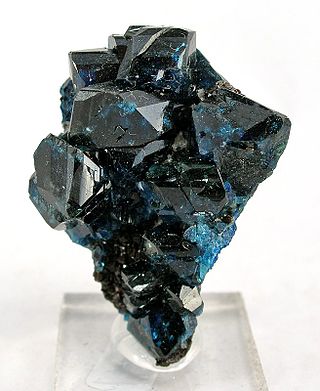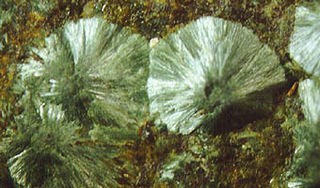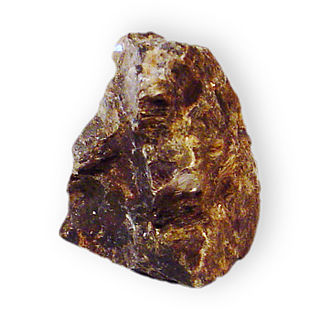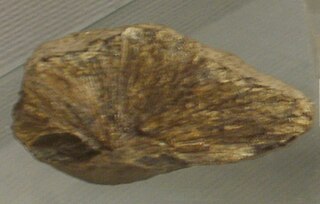Related Research Articles

The pyroxenes are a group of important rock-forming inosilicate minerals found in many igneous and metamorphic rocks. Pyroxenes have the general formula XY(Si,Al)2O6, where X represents calcium (Ca), sodium (Na), iron or magnesium (Mg) and more rarely zinc, manganese or lithium, and Y represents ions of smaller size, such as chromium (Cr), aluminium (Al), magnesium (Mg), cobalt (Co), manganese (Mn), scandium (Sc), titanium (Ti), vanadium (V) or even iron. Although aluminium substitutes extensively for silicon in silicates such as feldspars and amphiboles, the substitution occurs only to a limited extent in most pyroxenes. They share a common structure consisting of single chains of silica tetrahedra. Pyroxenes that crystallize in the monoclinic system are known as clinopyroxenes and those that crystallize in the orthorhombic system are known as orthopyroxenes.

Wardite is a hydrous sodium aluminium phosphate hydroxide mineral with formula: NaAl3(PO4)2(OH)4·2(H2O). Wardite is of interest for its rare crystallography. It crystallizes in the tetragonal trapezohedral class and is one of only a few minerals in that class. Wardite forms vitreous green to bluish green to white to colorless crystals, with pyramidal {102} or {114} faces and with {001} usually present masses. Also appears as fibrous encrustations. It has a Mohs hardness of 5 and a specific gravity of 2.81–2.87.

Lazulite or Azure spar is a transparent to semi-opaque, blue mineral that is a phosphate of magnesium, iron, and aluminium, with the chemical formula (Mg,Fe2+)Al2(PO4)2(OH)2. Lazulite forms one endmember of a solid solution series with the darker, iron-rich scorzalite.

Phosphate minerals are minerals that contain the tetrahedrally coordinated phosphate anion, sometimes with arsenate and vanadate substitutions, along with chloride (Cl−), fluoride (F−), and hydroxide (OH−) anions, that also fit into the crystal structure.

Vauxite is a phosphate mineral with the chemical formula Fe2+Al2(PO4)2(OH)2·6(H2O). It belongs to the laueite – paravauxite group, paravauxite subgroup, although Mindat puts it as a member of the vantasselite Al4(PO4)3(OH)3·9H2O group. There is no similarity in structure between vauxite and paravauxite Fe2+Al2(PO4)2(OH)2·8H2O or metavauxite Fe3+Al2(PO4)2(OH)2·8H2O, even though they are closely similar chemically and all minerals occur together as secondary minerals. Vauxite was named in 1922 for George Vaux Junior (1863–1927), an American attorney and mineral collector.

Pumpellyite is a group of closely related sorosilicate minerals:

Scorzalite ((Fe2+,Mg)Al2(OH,PO4)2) is a dark blue phosphate mineral containing iron, magnesium, and aluminium phosphate. Scorzalite forms one endmember of a solid solution series with the lighter, more magnesium-rich lazulite.

Alluaudite is a relatively common alkaline manganese iron phosphate mineral with the chemical formula (Na,Ca)Mn2+(Fe3+,Mn2+,Fe2+,Mg)2(PO4)3. It occurs as metasomatic replacement in granitic pegmatites and within phosphatic nodules in shales.

Hureaulite is a manganese phosphate with the formula Mn2+5(PO3OH)2(PO4)2·4H2O. It was discovered in 1825 and named in 1826 for the type locality, Les Hureaux, Saint-Sylvestre, Haute-Vienne, Limousin, France. It is sometimes written as huréaulite, but the IMA does not recommend this for English language text.

Lulzacite is a strontium-containing phosphate mineral with the chemical formula Sr2Fe2+(Fe2+,Mg)2Al4(PO4)4(OH)10.

Gormanite is a phosphate mineral with the formula (Fe,Mg)3Al4(PO4)4(OH)6·2H2O. It was named after the University of Toronto professor Donald Herbert Gorman (1922–2020).
This list gives an overview of the classification of non-silicate minerals and includes mostly International Mineralogical Association (IMA) recognized minerals and its groupings. This list complements the List of minerals recognized by the International Mineralogical Association series of articles and List of minerals. Rocks, ores, mineral mixtures, not IMA approved minerals, not named minerals are mostly excluded. Mostly major groups only, or groupings used by New Dana Classification and Mindat.
This list gives an overview of the classification of minerals (silicates) and includes mostly International Mineralogical Association (IMA) recognized minerals and its groupings. This list complements the List of minerals recognized by the International Mineralogical Association series of articles and List of minerals. Rocks, ores, mineral mixtures, non-IMA approved minerals and non-named minerals are mostly excluded.

Whiteite is a rare hydrated hydroxyphosphate mineral.

Maricite or marićite is a sodium iron phosphate mineral (NaFe2+PO4), that has two metal cations connected to a phosphate tetrahedron. It is structurally similar to the much more common mineral olivine. Maricite is brittle, usually colorless to gray, and has been found in nodules within shale beds often containing other minerals.

Satterlyite is a hydroxyl bearing iron phosphate mineral. The mineral can be found in phosphatic shales and was first discovered in the Big Fish River area in Yukon Territory, Canada.
Falsterite is a rare phosphate mineral with the formula Ca2MgMn2+2(Fe2+0.5Fe3+0.5)4Zn4(PO4)8(OH)4(H2O)14. It is a pegmatitic mineral, related to the currently approved mineral ferraioloite.
Fluorcarmoite-(BaNa) is a rare phosphate mineral, belonging to arrojadite group, with the formula Ba[]Na2Na2[]CaMg13Al(PO4)11(PO3OH)F2. It is a barium-rich member of the group, as is arrojadite-(BaNa), arrojadite-(BaFe), fluorarrojadite-(BaFe) and an unapproved species ferri-arrojadite-(BaNa). The "-(BaNa)" suffix informs about the dominance of the particular elements (here barium and sodium) at the corresponding structural sites.
Manganese phosphate may refer to:
References
- ↑ Warr, L.N. (2021). "IMA–CNMNC approved mineral symbols". Mineralogical Magazine. 85 (3): 291–320. Bibcode:2021MinM...85..291W. doi: 10.1180/mgm.2021.43 . S2CID 235729616.
- ↑ Mineralienatlas
- 1 2 Bowman, Michael G.; Downs, Robert T.; Yang, Hexiong (15 February 2013). "Penikisite, BaMg 2 Al 2 (PO 4 ) 3 (OH) 3 , isostructural with bjarebyite". Acta Crystallographica Section E. 69 (2): i4–i5. doi: 10.1107/S1600536812051793 . PMC 3569169 . PMID 23424395.
- 1 2 3 Elliott, P. & Willis A.C., ["The crystal structure of perloffite"], Mineralogical Magazine, 2011
- 1 2 3 4 5 6 7 8 9 10 Mandarino, J.A., Sturman, B.D. & Corlett, M.I., ["Penikisite, the magnesium analogue of kulanite, from the Yukon Territory"], Can. Mineral, 1977
- ↑ Bowman, Downs & Yang 2013.
- ↑ Anthony, John W., Richard A., Kenneth W. and Nichols, Monte C. Eds., ["Penikisite"], Handbook of Mineralogy, Mineralogical Society of America, Chantilly, VA, 2001–2005
- 1 2 3 4 Cooper M. & Hawthorne F.C., ["Refinement of the crystal structure of kulanite"], Can. Mineral, 1994
- 1 2 3 Robertson, B.T. ["Occurrence of epigenetic phosphate minerals in a phosphatic iron-formation, Yukon Territory"], Mineral. Rec., 1982